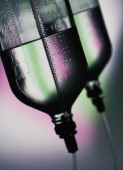
TUESDAY, Jan. 26 (HealthDay News) — Among adult septic shock patients, intensive insulin therapy to lower high blood glucose levels caused by corticosteroid therapy doesn’t reduce the risk of death, a new study has found.
The death rate for septic shock — a major complication of bacterial infections — is 60 percent within a short period, according to background information in the study. Corticosteroids are used to treat septic shock but their use is associated with elevated blood glucose levels (hyperglycemia).
In the new study, published in the Jan. 27 issue of the Journal of the American Medical Association, researchers in France examined whether intensive insulin therapy would improve outcomes among adult septic shock patients treated with hydrocortisone.
The study included 509 patients randomly selected to one of four groups: continuous intravenous infusion with hydrocortisone alone; continuous intravenous infusion with hydrocortisone plus another corticosteroid called fludrocortisone; conventional insulin therapy with hydrocortisone alone; or conventional insulin therapy with intravenous hydrocortisone plus fludrocortisone. Hydrocortisone was administered every six hours, and fludrocortisone was administered once daily for one week.
Overall, 117 of the 255 patients (45.9 percent) treated with intensive insulin therapy died, along with 109 of 254 (42.9 percent) of patients who received conventional insulin therapy. There were no major differences between the two groups in any of the secondary outcome measures, such as days spent in the intensive care unit or length of hospital stay.
The researchers also found that patients in the intensive insulin therapy group had significantly more episodes of hypoglycemia (low blood sugar) than those in the conventional insulin therapy group.
The use of a second corticosteroid offered no benefit. The death rate for patients who received fludrocortisone was 42.9 percent, compared with 45.8 percent for those in the conventional insulin therapy group.
“The current study showed no evidence to support a strategy of intensive insulin therapy aimed at maintaining blood glucose levels in the range of 80 to 110 milligrams per deciliter for treating septic shock with corticosteroids,” the researchers wrote. “The current data do not support the routine use of oral fludrocortisone in addition to hydrocortisone when physicians decide to introduce corticosteroids in the management of a patient with septic shock.”
More information
The U.S. National Institute of General Medical Sciences has more about sepsis.

